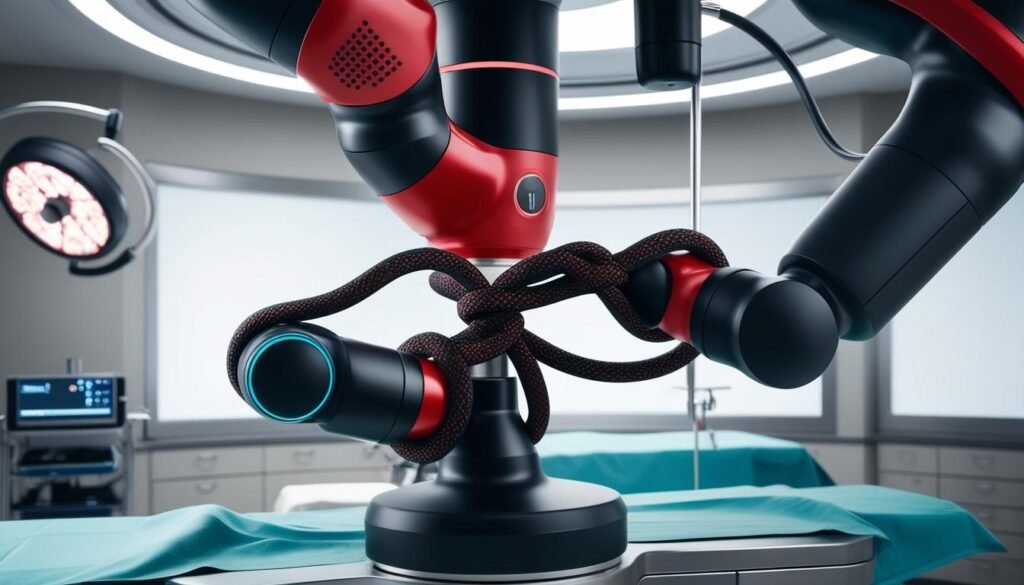Advancements in surgical robotics are paving the way for increased automation, potentially transforming surgical procedures and the surgeon’s role in the operating theatre.
Recent advancements in surgical robotics are steering the field towards increased automation, a development that could transform the landscape of surgical procedures. Researchers from Johns Hopkins University and Stanford University are pioneering this shift through the exploration of advanced imitation learning techniques, suggesting that future surgical robots may operate with significantly less human oversight than current platforms.
Traditionally, surgical robots rely on joystick-like hand controllers which place the surgeon firmly in command of each manoeuvre. However, the ongoing research indicates a promising trend wherein robots can learn and perform fundamental surgical tasks by analysing video recordings of seasoned surgeons. This innovative approach allows these robots to develop intricate procedural models capable of undertaking diverse delicate operations, such as tissue manipulation, needle handling, and knot-tying.
An abstract released by the research team discusses the potential of leveraging extensive clinical data — which possesses approximate kinematics — to enhance robot learning without the need for additional corrections. In experiments that employed Intuitive Surgical’s da Vinci Research Kit (dVRK), it was observed that policies based on camera-centric absolute positioning often failed to execute tasks effectively, encountering significant challenges with tissue manipulation and suture handling. These issues resulted in nearly zero success for certain tasks. In contrast, the use of relative action formulations, which define movements in relation to the robot’s current end-effector or camera frame, yielded much more promising results.
Specific tasks such as tissue lifting and needle pickups consistently succeeded across trials, while the success rate for knot-tying approached 90%, with 18 out of 20 attempts successful. This method of operation provides the robotic system with enhanced dexterity and precision, allowing it to navigate the complexities of working with sensitive tissues and instruments more efficiently.
Furthermore, Intuitive Surgical has been developing more sophisticated control mechanisms, as indicated by CEO Gary Guthart and UC Berkeley professor Ken Goldberg, who introduced the concept of “augmented dexterity.” This framework envisions a scenario where surgical robots can autonomously manage specific sub-tasks — such as suturing and debridement — while the surgeon remains nearby to make critical decisions and execute complex maneuvers. By integrating advanced imaging technology and AI-driven guidance with real-time human oversight, this approach aspires to create a hybrid model that combines traditional teleoperation with elements of full autonomy.
The future implications of these advancements could be significant, as they suggest a trend towards increasingly autonomous surgical systems capable of performing complex tasks with reduced human intervention. The progressive research initiatives highlighted in this domain reflect a growing interest in refining surgical robotics, with a focus on enhancing operational capabilities and improving surgical outcomes. As these technologies continue to evolve, they may not only change the dynamics of surgical practice but also redefine the roles of surgeons in the operating theatre.
Source: Noah Wire Services
- https://www.fastcompany.com/91226566/doctors-built-an-ai-that-taught-itself-how-to-do-surgery-and-its-ready-to-work-on-humans – This article discusses the research by Johns Hopkins and Stanford researchers who developed an AI that learned to perform surgery by watching videos of surgeries, using imitation learning and the da Vinci Surgical System.
- https://www.fastcompany.com/91226566/doctors-built-an-ai-that-taught-itself-how-to-do-surgery-and-its-ready-to-work-on-humans – It explains how the AI analyzed video recordings to learn and perform surgical tasks such as tissue manipulation, needle handling, and knot-tying.
- https://www.fastcompany.com/91226566/doctors-built-an-ai-that-taught-itself-how-to-do-surgery-and-its-ready-to-work-on-humans – The article details the use of relative action formulations instead of absolute positioning, which improved the robot’s success in tasks like tissue lifting and needle pickups.
- https://pubmed.ncbi.nlm.nih.gov/38231455/ – This article discusses the advancements in robotic surgery, including the integration of AI and machine learning to improve surgical accuracy and reduce human error.
- https://pubmed.ncbi.nlm.nih.gov/38231455/ – It highlights the future prospects of robotic surgery, including the potential for autonomous surgical systems and the impact of 5G connectivity on remote surgery.
- https://blog.engineering.vanderbilt.edu/the-future-of-surgery-augmentation-and-automation-in-healthcare – This article explains how robot-assisted surgeries enhance precision and reduce complications, and how AI algorithms can further improve surgical outcomes.
- https://blog.engineering.vanderbilt.edu/the-future-of-surgery-augmentation-and-automation-in-healthcare – It discusses the benefits of robotic systems, such as being fatigue and tremor resistant, and their ability to work with greater range of axial movement.
- https://www.fastcompany.com/91226566/doctors-built-an-ai-that-taught-itself-how-to-do-surgery-and-its-ready-to-work-on-humans – The article mentions the use of the da Vinci Surgical System and virtual simulations to validate the AI’s learning process and its ability to adapt to new surgical scenarios.
- https://pubmed.ncbi.nlm.nih.gov/38231455/ – It discusses the challenges and future prospects of robotic surgery, including the integration of advanced materials, imaging technologies, and teleoperation.
- https://blog.engineering.vanderbilt.edu/the-future-of-surgery-augmentation-and-automation-in-healthcare – The article highlights the concept of ‘augmented dexterity’ and the potential for surgical robots to autonomously manage specific sub-tasks while the surgeon makes critical decisions.
- https://www.fastcompany.com/91226566/doctors-built-an-ai-that-taught-itself-how-to-do-surgery-and-its-ready-to-work-on-humans – It details the success rates of the robot in tasks like knot-tying and the overall enhanced dexterity and precision achieved through relative action formulations.


